[A pdf version of this survey report is available here.]
Executive Summary
The Center for Radically Inclusive Judaism (CFRIJ), with the cooperation of Reconstructing
Judaism, conducted a survey of Reconstructionist congregations’ interfaith inclusion policies and
practices in April and May 2021. We thank Rabbi Maurice Harris, Reconstructing Judaism’s
Associate Director for Thriving Communities and Israel Affairs Specialist, for his guidance and
assistance with the project. Rabbi Harris invited the movement’s 97 synagogues and havurot to
participate in the survey; 47, or 48%, did respond to the survey. Key findings include:
Recognition and Equal Treatment
• 23% of congregations said that they do not draw any distinctions in terms of leadership
and governance, ritual participation, or otherwise, between Jews and partners from
different faith backgrounds; 74% said they draw some distinctions.
• 70% of congregations celebrate partners from different faith backgrounds, for example by
offering special blessings for them or their relatives at lifecycle events; 30% do not.
Membership and Leadership
• Eighty-nine percent of congregations count partners from different faith backgrounds as
full voting members; 68% permit them to serve as Board members, 66% as officers other
than President; 62% permit them to serve as chairs of some committees, 49% as chairs of
all committees; 28% permit them to serve as President. Only 2% do not count partners
from different faith backgrounds as full voting members or permit them to hold
leadership positions.
• In 51% of congregations, members from different faith backgrounds currently serve as
officers, board members or committee chairs (in 49% they do not); 40% have them
serving as committee chairs, 30% as board members, 23% as officers other than
President, and 2% as President.
Ritual Participation
• Fifty-five percent of congregations permit members from different faith backgrounds to
lead the lighting of Shabbat and holiday candles by themselves; 36% permit them to do
so with someone who is Jewish; 9% permit neither.
• Forty-nine percent of congregations permit members from different faith backgrounds to
lead kiddush during services by themselves; 32% permit them to do so with someone
who is Jewish; 19% permit neither.
• At their b’nai mitzvah services, 34% of congregations allow a parent from a different
faith background to have, by themselves, an Aliyah/recite the blessings before and after
the Torah is read; 47% allow such parents to join with a Jewish parent in an Aliyah/recite
the Torah blessings; 17% allow such parents to stand quietly next to someone who is
Jewish during an Aliyah and/or recite a prayer other than the Torah blessings from the
bimah; 2% permit none of these forms of participation.
• In 68% of congregations, a Torah is passed during b’nai mitzvah services to the b’nai
mitzvah child; in 69% of those, it is passed by relatives including relatives from different
faith backgrounds, in 31%, only by Jewish relatives.
• Sixty-four percent of congregations do not have or control a section of a cemetery. Of the
36% that do have or control a section of a cemetery, 59% allow partners of a different
faith to be buried beside their Jewish partner anywhere in the cemetery; 35% allow them
to be buried beside each other in a section of the cemetery designated for interfaith
families.
Dual Education
• Eighty-one percent of congregations have religious schools; of those, 55% allow children
who are receiving formal religious education in another religion to attend their religious
school; 45% do not.
Wedding Officiation
• In 87% of congregations, some or all of the clergy officiate at weddings of interfaith
couples; the clergy in 64% of congregations will only officiate, while in 23% they will
co-officiate as well as officiate; in 13% the clergy will do neither.
• Of the congregations where some or all of the clergy officiate at weddings of interfaith
couples, 12% do so without conditions; 20% do with conditions (for example, if the
family will be a Jewish family, if children will be raised as Jews, if Judaism will be the
only religion in the home, if the partner from a different faith background has had some
education about Judaism, etc.); 56% do so with guidelines in mind but without strictly
applied conditions, allowing for some case-by-case discernment.
• In addition to the 23% of congregations whose clergy will co-officiate, another 43% had
clergy who will allow some participation of clergy of different faiths. Of that total of 65%
of congregations, the clergy in 61% will not co-officiate but will allow clergy of other
faiths to offer a blessing; 13% will co-officiate without conditions; 23% will co-officiate
if the clergy from other faiths agrees to religiously neutral content, for example, saying
“God” and not “Jesus” in their prayers.
• Eighty-seven percent of congregations permit weddings of interfaith couples to take place
in their worship space, 13% do not.
Messaging, Programming and Training
• On their websites: 79% of congregations regularly explain/translate Hebrew words and
“insider phrases”; 45% include images of interfaith families incorporating Judaism in
their lives; 38% have a section that addresses interfaith families; 36% publish their
policies and practices with regard to interfaith families (in terms of leadership and
governance, ritual participation, and lifecycle officiation); 23% have links that provide
Jewish resources specifically for interfaith families.
• Forty percent of communities offer programs that address issues that relate particularly to
interfaith couples; 26% have had speakers about issues facing interfaith families in
Jewish communities and Jewish life; 11% have an affinity group for interfaith families;
4% have a committee that specifically addresses interfaith families; 51% do not have
these groups or programs.
• Seventy-nine percent of congregations advertise outside of their community that they
welcome interfaith families; 21% do not. The mission statements of 60% of
congregations refer to their approach to interfaith family inclusion; those of 40% do not.
• Six percent of congregations provide trainings for their professional staff on how to serve
the specific needs of interfaith families; 11% provide such trainings for their lay leaders;
87% do not provide such trainings.
• Thirty-six percent have done a community organizing or listening campaign specifically
involving interfaith families to better understand their needs and how their community
can serve them; 64% have not.
Report
Methodology
The Center for Radically Inclusive Judaism (CFRIJ), with the cooperation of Reconstructing
Judaism, conducted a survey of Reconstructionist congregations’ interfaith inclusion policies and
practices in April and May 2021. We thank Rabbi Maurice Harris, Reconstructing Judaism’s
Associate Director for Thriving Communities and Israel Affairs Specialist, for his guidance and
assistance with the project. Rabbi Harris invited the movement’s 97 synagogues and havurot to
participate in the survey; 47, or 48%, did respond to the survey. A list of the congregations that
responded is attached as Exhibit 1.
The responding congregations compare in size, in terms of number of members, to
Reconstructionist congregations as a whole, as follows:
| Size of congregation (members) | # of RJ congregations | % of 97 RJ congregations | # of survey responses | % of 47 survey responses | % of category that responded |
| 70 or less | 32 | 33% | 12 | 26% | 38% |
| 71-150 | 26 | 27% | 10 | 21% | 38% |
| 151-300 | 24 | 25% | 16 | 34% | 67% |
| 301-450 | 9 | 9% | 7 | 15% | 78% |
| 451 or more | 6 | 6% | 2 | 4% | 33% |
The survey asked questions about leadership and governance; ritual participation; dual
education; lifecycle officiation; messaging, programming and training; full inclusion; and
recognition and equal treatment. Each section of questions included an open-ended question in
which respondents could explain or comment on their answers.
Membership and Leadership Roles
Forty-seven congregations answered a question about bylaws; only one said it did not have
bylaws. Of the respondents, 89% count partners from different faith traditions as full voting
members; 68% permit them to serve as Board members; 66% permit them to serve as officers
other than President; 62% permit them to serve as chairs of some and 49% of all committees;
28% permit them to serve as President; 2% do not count them as full voting members or permit
them to hold leadership positions.
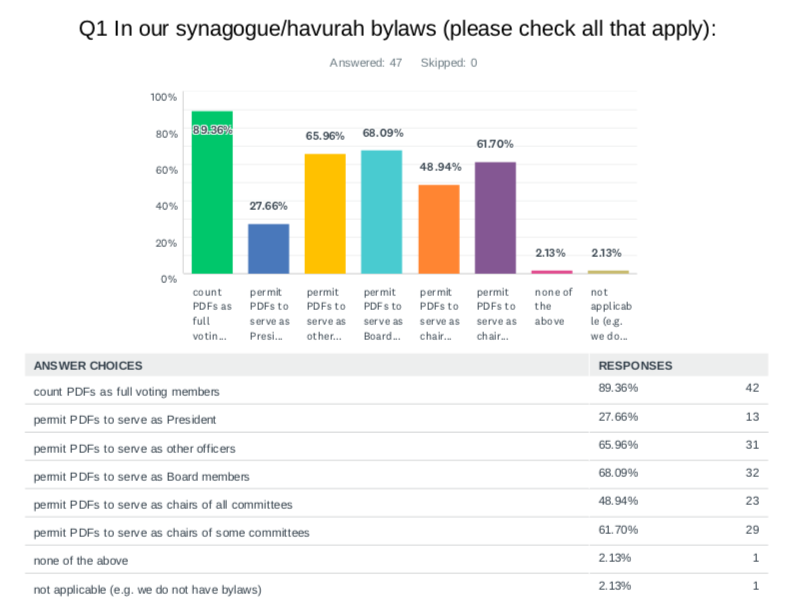
Twenty-four congregations (51%) indicated that members from different faith backgrounds
currently serve as officers, board members or committee chairs (in 49%, they do not);
40% have them serving as board members, 43% as chairs of committees, 30% as board
members, 23% as officers other than president, and 2% (representing one congregation) as
president.
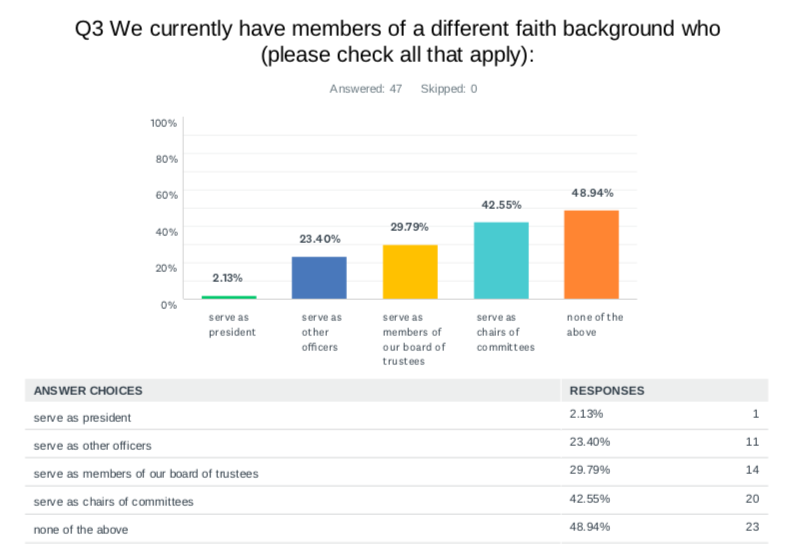
There were 26 responses to an open-ended question asking for explanations of the answers about
leadership and governance.
• Five congregations indicated they were or hoped to soon re-evaluate their inclusivity
policies/update their by-laws.
• One congregation’s by-laws require that 51% of the board be Jewish; another requires
two-thirds “in order to maintain the Jewish identity of the institution.”
• One congregation’s by-laws do not permit members from different faith backgrounds to
vote on rabbi selection, ritual matters, or amending the by-laws.
• One congregation has a membership category for those who are not Jewish or partnered
with a Jew. One congregation’s by-laws permit the board to waive the requirement that
members be Jewish or family members on a case-by-case basis.
• One comment said: “Our by-laws are a bit different in that they don’t ‘permit’ but they
‘do not exclude.’ A non-Jewish person can be a full member, and a full member can
serve.”
Ritual Participation
Twenty-six congregations (55%) permit members of different faith backgrounds to lead the
lighting of Shabbat and holiday candles by themselves; 17 (36%) permit them to do so with
someone who is Jewish; 4 (9%) permit neither.
Twenty-three congregations (49%) permit members of different faith backgrounds to lead
kiddush during services by themselves; 15 (32%) permit them to do so with someone who is
Jewish; 9 (19%) permit neither.
At their b’nai mitzvah services, 16 congregations (34%) allow a parent from a different faith
background to have, by themselves, an Aliyah/recite the blessings before and after the Torah is
read; 22 congregations (47%) allow such parents to join with a Jewish parent in an Aliyah/recite
the Torah blessings; 8 congregations (17%) allow such parents to stand quietly next to someone
who is Jewish during an Aliyah and/or recite a prayer other than the Torah blessings from the
bimah; 1 congregation (2%) permit none of these forms of participation.
In addition, in 68% of congregations a Torah is passed during b’nai mitzvah services to the b’nai
mitzvah child; in 69% of those, it is passed by relatives including relatives from different faith
backgrounds, but by only Jewish relatives in 31%.
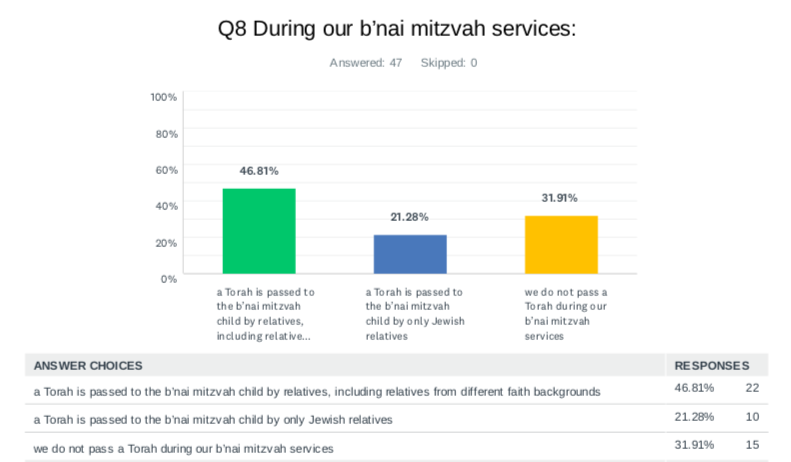
Twenty-nine congregations (62%) celebrate conversions during regular worship services; 18
(38%) do not.
Thirty congregations (64%) do not have or control a section of a cemetery. Of the 17 (36%) that
do have or control a section of a cemetery, 10 (59%) allow partners of a different faith to be
buried beside their Jewish partner anywhere in the cemetery; 6 (35%) allow them to be buried
beside each other in a section of the cemetery designated for interfaith families; 1 (6%) has a
cemetery or section where such burials can be anywhere, and another where they can be in a
designated area.
There were nineteen open-ended comments to the ritual participation questions. One said that
their congregation’s written restriction to Jews only for candle lighting and kiddush was
changing to greater inclusivity in practice. Six comments referred to cemeteries; one
congregation is thinking about their policy, one is working on buying plots where interfaith
couples could be buried.
With respect to Aliyot, one said, “Because the wording of the blessings includes references to
being part of the Jewish people to whom the Torah was originally given, only the adult Jewish
members of the family recite the blessing.” Another said, “We have few to no non-Jewish
members who seek to participate in services. We have had only one family request that a non-
Jewish family member have an Aliyah.”
With respect to b’nai mitzvah services, one said, “We are especially attentive to the non-Jewish
parent/family members during a Bar/Bat Mitzvah. We let them know how important they are in
the Jewish life of their child. We make a special blessing for non-Jewish parents and
grandparents that highlights their respect of and support for Jewish traditions.” Another said
about passing the Torah: “The other-background parent stands with the Jewish parent, but only
the Jewish parent physically passes the Torah. We verbally honor the other parent’s role in
supporting the transmission of Torah.”
Dual Education
Thirty-eight congregations (81%) have religious schools; of those, 21 (55%) allow children who
are receiving formal religious education in another religion to attend their religious school; 17
(45%) do not.
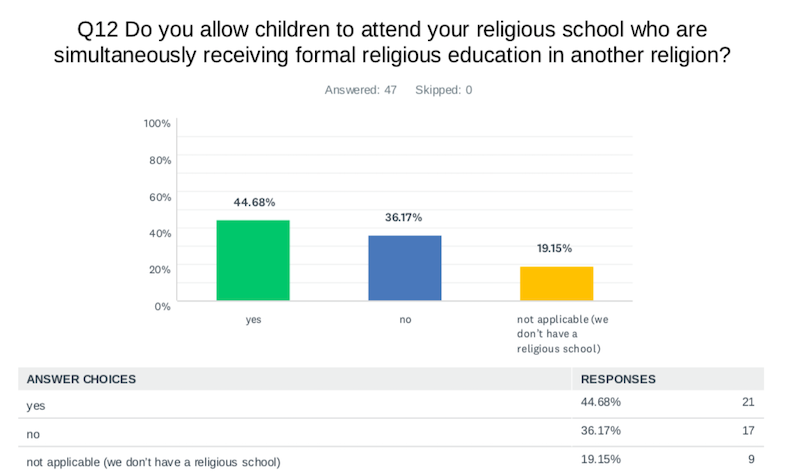
One open-ended comment on dual education said “they are allowed to be educated in two
religions, but in order to enter the b’nai mitzvah process they have to be fully committed to
Judaism. The policy has a lot of nuances.”
Lifecycle Officiation
In 41 congregations (87%), some or all of the clergy officiate at weddings of interfaith couples;
the clergy in 30 congregations (64%) will only officiate, while in 11 (23%) they will co-officiate
as well as officiate; in 6 congregations (13%) the clergy will do neither.
Please note that the responses to questions about clergy who co-officiate at weddings are not
necessarily reflective of the practices of members of the RRA. Some of the clergy who serve
Reconstructionist communities are rabbis from other denominations, and in many cases the
people who completed the survey are not clergy themselves and may have different
understandings of the meaning of co-officiation.
Of the 41 congregations’ clergy who officiate at weddings of interfaith couples, 5 (12%) do so
without conditions; 8 (20%) do with conditions (for example, if the family will be a Jewish
family, if children will be raised as Jews, if Judaism will be the only religion in the home, if the
partner from a different faith background has had some education about Judaism, etc.); 23 (56%)
do so with guidelines in mind but without strictly applied conditions, allowing for some case-by-
case discernment; 1 (2%) response was without conditions/with guidelines; 4 (10%) responses
were with conditions/with guidelines.
Of the 31 congregations’ clergy who will either co-officiate at weddings of interfaith couples
with clergy of another faith or allow clergy of other faiths to offer a blessing, 19 (61%) will not
co-officiate but will allow clergy of other faiths to offer a blessing; 4 (13%) will co-officiate
without conditions; 7 (23%) will co-officiate if the clergy from other faiths agrees to religiously
neutral content, for example, saying “God” and not “Jesus” in their prayers. One respondent
(3%) said they do not co-officiate but allow a blessing and that they co-officiate if the other
clergy agrees to neutral language.
Forty-one congregations (87%) permit weddings of interfaith couples to take place in their
worship space, 6 (13%) do not.
Open-ended comments included:
• “Our rabbi does not ‘officially’ perform interfaith marriages but is open to considering on
a case-by-case basis.”
• “Rabbi hasn’t been asked to officiate at an interfaith wedding of one of our members and
hasn’t made any decision about how she would handle that if asked.”
• “Not sure if rabbi would co-officiate. We haven’t had to discuss this situation.”
• “Both [officiants] are unwilling to provide a ceremony to satisfy other family than the
couple themselves.”
• “We are very attentive to the parents of the non-Jewish partner. I meet by phone with
them to offer ways to participate and to reassure them that they will not be treated as
outsiders as their own son or daughter’s wedding.”
Messaging, Programming and Training
On their websites:
• 79% of congregations regularly explain/translate Hebrew words and “insider phrases”
• 45% include images of interfaith families incorporating Judaism in their lives
• 38% have a section that addresses interfaith families
• 36% publish their policies and practices with regard to interfaith families (in terms of
leadership and governance, ritual participation, and lifecycle officiation)
• 23% have links that provide Jewish resources specifically for interfaith families
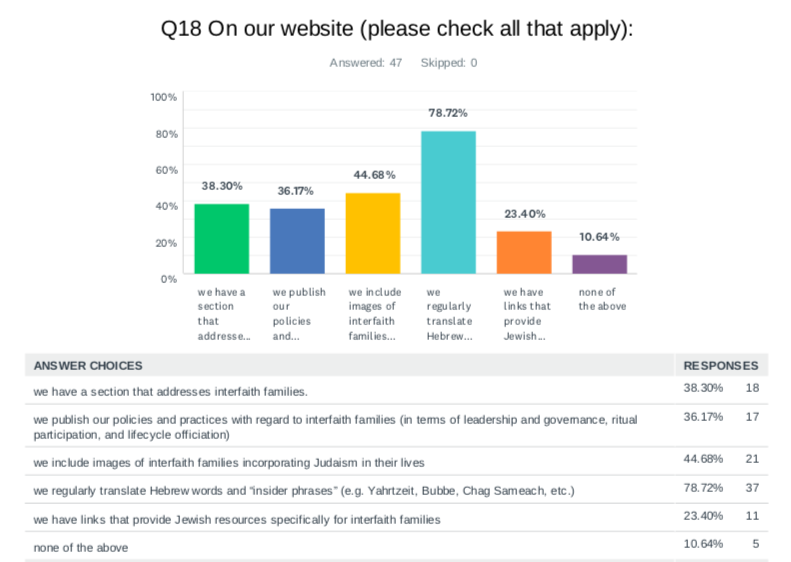
Forty percent of communities offer programs that address issues that relate particularly to
interfaith couples; 26% have had speakers about issues facing interfaith families in Jewish
communities and Jewish life; 11% have an affinity group for interfaith families; 4% have a
committee that specifically addresses interfaith families; 51% do not have these groups or
programs.
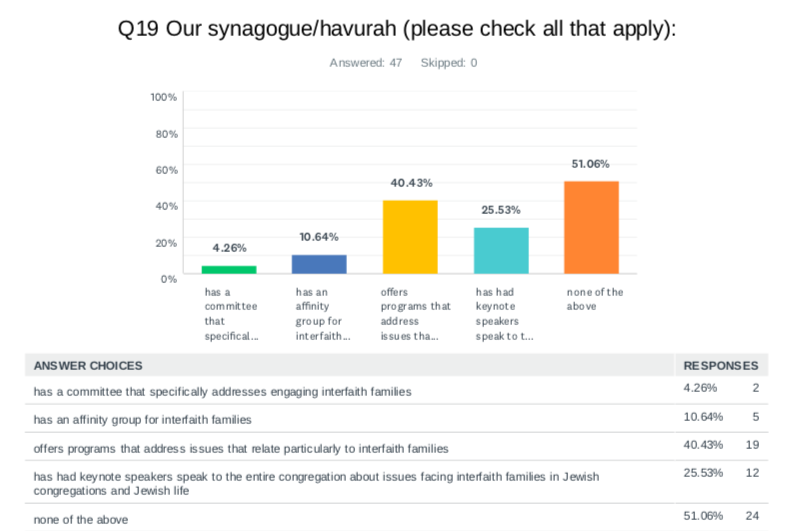
Seventy-nine percent of congregations advertise outside of their community that they welcome
interfaith families; 21% do not.
Six percent of congregations provide trainings for their professional staff on how to serve the
specific needs of interfaith families; 11% provide such trainings for their lay leaders; 87% do not
provide such trainings.
Thirty-six percent have done a community organizing or listening campaign specifically
involving interfaith families to better understand their needs and how their community can serve
them; 64% have not.
The mission statements of 60% of congregations refer to their approach to interfaith family
inclusion; those of 40% do not.
In open-ended comments, four congregations indicated that they did not offer training for staff or
lay leaders because they are small, but in the words of one, that did not indicate a “lack of
welcoming sensitivity.” One said “Because we have so many interfaith households, we have not
needed to do trainings. It’s usually a non-issue.” With respect to affinity groups, one said, “The
interfaith families have not yet expressed an interest in an affinity group, we have informally
asked.”
One said that the About page of their website says that they are a welcoming community that
strives to be “radically inclusive. Our membership includes interfaith families … and people who
do not come from Jewish backgrounds who find connection and resonance with what we do.”
They added, “We’re grateful to this survey for offering some new ideas and we look forward to
RJ’s resources on the topic.”
Finally, one said, “Our congregation does not have formal committees for meeting the needs of
interfaith families. Rather, we have in depth personalized outreach to all our members at least
annually. The majority of our families are interfaith. We try to emphasize during these outreach
calls that [our congregation] welcomes ALL members of their family and to ask for their
feedback about our efforts to be welcoming. Many interfaith families have told us that they
joined our congregation because we were the most welcoming congregation in the region for
interfaith families.”
Recognition and Equal Treatment
Seventy percent of congregations celebrate partners from different faith backgrounds, for
example by offering special blessings for them or their relatives at holidays or lifecycle events;
30% do not.
Seventy-four percent of congregations said that they draw some distinctions in terms of
leadership and governance, ritual participation, and otherwise, between Jews and partners from
different faith backgrounds; 23% said they did not draw any distinctions. One congregation (2%)
selected both answers.
Of the eleven congregations that said they do not draw any distinctions, ten allow a partner from
a different faith background to have an Aliyah by themselves; eleven allow them to be an officer,
but only nine a board member, and only seven, President.
There were several open-ended responses that indicated a maximally inclusive approach:
• “It is all over our literature that we are inclusive…. The inclusion of people of different
faiths in the governance of the congregation was established by 1981. The ‘last frontier’
toward complete inclusion concerned ritual practice. When the change in our bylaws was
proposed 6 years ago offering full inclusion, it was passed unanimously. In this case
‘law’ reflected ‘practice.’ There was tacit inclusion before the bylaws change.”
• “We give equal access vs. a special blessing.”
Other responses indicated a more nuanced approach:
• “We have at times had exploratory committees come up with a policy re: specifying roles
that are appropriate for non-Jews to hold, with the conclusion being that brachot that
include ‘asher kidshanu b’mitzvotav…’ should be said by Jews only. In practice, this is
not the case. In practice we for the most part do not differentiate between Jews and non-
Jews in our congregation.”
• “We only count Jews for a minyan, although, we’ve made exceptions when the number is
close.”
• [By a congregation that allows partners from different faith backgrounds to have an
Aliyah with someone who is Jewish] “There are conversations with families before life
cycle events on how family members are going to participate. We don’t make any
distinctions during the events – they all seem seamless.”
Two comments expressed a more restrictive approach:
• “I believe ritual is valuable and transformative because it names what is true. I do not
think it makes sense to ask someone who does not identify with Judaism to bless the
Torah proclaiming they are Jewish and accept Torah.”
• “Our overarching ritual guideline is being ‘real and true.’ For example we think it’s real
and true that folk who aren’t Jewish are important members of our community. We think
it’s not real and true for such a person to affirm that God gave them the Torah or that they
have the Jewish relationship to the Torah.”
Full Inclusion
The survey included two open-ended questions – what are some things your congregation does to
create a sense of inclusion of interfaith families, and what are some things you would like to do
differently.
Some of the responses described an overall approach of inclusivity:
• “Members of interfaith families take visible leadership roles in governance and ritual,
including members who do not identify as Jewish. Our family education program is
geared for interfaith families. We try to articulate being a community of people drawn to
each other and to our style of spiritual journey without doing any traditional Jewish
gatekeeping.”
• “Ritual inclusion, readings and prayers that reflect different faiths and backgrounds,
public leadership roles, school inclusion, space for people to talk about other faith
celebrations.”
• “We name the fact that interfaith families are welcome and present. We encourage
students in Hebrew school to speak about their different heritages. We give the interfaith
parents equal treatment in lifecyle events. We have had families speak about being
interfaith at special synagogue events called ‘tishes.’ We make sure interfaith families are
included in our in-home Shabbat dinners. We honor all family traditions, including those
with Christmas trees hosting congregational events in December.”
• “We have specific things on our website that address welcoming interfaith families. We
translate all terms in Hebrew and only recite prayers in our siddur that have
transliteration. We have done religious school programming on interfaith families and
identity, we actively acknowledge that non-Jews are members and celebrated, we have
offered adult education – i.e. “Jew-ish” a program that had language encouraging
interfaith members to participate, our clergy officiate interfaith weddings, we have non-
Jewish committee and board members.”
Some responses emphasized careful use of language:
• “We acknowledge their presence and are intentional about language and prompt for
discussion and connection that talks about one’s relationships to Jews and Jewishness
without assuming everyone is Jewish.”
• “Our service leaders. are cautious about ‘we’ language when it comes to observing
certain traditions or not observing others (i.e. we name that some of our members may
celebrate Christmas in their home, may wish a happy Easter to those who celebrate, avoid
saying things about how ‘we don’t’ or ‘Jews don’t’ do this or that.)
• “Use language like ‘people who love Jews’ rather than ‘non-Jews’.”
Some responses focused on explicit statements and other inclusive actions:
• “We see God’s face in everyone: Jews by birth, Jews by choice, interfaith families; …”
• “We acknowledge that most of us lived in homes with a mix of traditions. We do not
question anyone about their background.”
• “As the rabbi, I have taught Torah about the power and importance of interfaith families
in our tradition.”
• “We emphasize that we are and always have been welcoming and inclusive of interfaith
families: many of our past presidents, officers and leaders are in interfaith families.”
• “Bless parents of interfaith family at b’nei mitzvah specifically naming the parent from
another faith tradition’s importance in supporting the child’s Jewish learning and identity
and their embrace of Judaism if appropriate.”
• “We have a ‘buddy system’ … if new members are interested in an interfaith buddy, we
often connect them with several long time members who can answer questions about our
interfaith welcome.”
• “Include interfaith life in our religious school curriculum.”
Responses to the question about what congregations could do differently included “recruit non-
Jewish members to serve on the board” and “Perhaps we should advertise more outside the
Jewish community to reach interfaith families who might not know we exist.” Others included:
• “I would like to see us have an affinity group of non-Jews in our community to learn
about Jewishness and Judaism, allyship, and how to support a Jewish partner/kids, as well
as a way of making sure they can support one another in investing in their own inclusion.
Additionally, I wonder about creating liturgy that is specific for non-Jews to say that
speaks to their relationship with Judaism and Jewish community.”
• “Outreach to non-Jewish members of the synagogue to engage them in congregational
life and connect them with other members of the community in the same (or sometimes
greater) way than to Jewish members of the congregation – as non-Jewish members of our
community (especially newer ones) may either have limited experience as members of a
synagogue/Jewish community, or be uncertain of the level to which they are welcome.
We could do more to make sure this is clear.”
• “I think we could be more explicit and appreciative of non-Jewish partners raising Jewish
children. We could have more speakers and/or special events targeted to those families
(though our interfaith families have expressed joy at being integrated and have resisted
separate events so far).”
Finally, one said, about things to do differently, “None at this time. We like who we are and how
we approach our worship, inclusion, and sense of family.”
Discussion
This survey is modeled on the Center’s December 2019 Survey on Reform Synagogue Interfaith
Inclusion Policies and Practices and December 2020 Survey on Emerging Spiritual
Communities’ Interfaith Inclusion Policies and Practices. As stated in the reports on those
surveys:
“Interpretation of the significance of the data yielded by this survey depends to a large
extent on the interpreter’s perspective with respect to inclusion of interfaith families. The
same data can be stated in ways that emphasize permission or restriction; for example,
40% of congregations permit X, or, 60% of congregations do not permit X. In turn,
whether or not it is appropriate or advisable to permit or not permit X depends on one’s
fundamental views: about Judaism – whether it is a system for those who are Jewish or
also those who do Jewish; about the relative importance of maintaining boundaries, on
the one hand, and engaging interfaith families in Jewish life, on the other; and about
whether restriction or permission will lead to interfaith family engagement.”
In terms of membership and leadership, 89% of Reconstructionist congregations count partners
from different faith backgrounds as voting members, 68% permit them to serve as board
members and 66% as some officers; 30% have partners from different faith backgrounds serving
as board members and 23% as officers.
In terms of ritual participation, 91% of Reconstructionist congregations permit members from
different faith backgrounds to lead the lighting of Shabbat and holiday candles during services;
81% allow a parent from a different faith background to have an Aliyah/recite the blessings
before and after the Torah is read.
In the Center’s view, full inclusion of partners from different faith backgrounds requires that
they be considered and treated as equal to their Jewish partners. From that perspective, a key
measure of inclusion is whether a partner from a different faith background is allowed to
participate or lead a ritual by themselves, as opposed to with someone who is Jewish. In this
regard, 55% of Reconstructionist congregations allow such partners to lead the lighting of
Shabbat and holiday candles during services by themselves; 34% allow such partners to have an
Aliyah by themselves. An important related finding is that 23% of Reconstructionist
congregations say that they do not draw any distinctions in terms of leadership and governance,
ritual participation, and otherwise, between Jews and partners from different faith backgrounds.
It appears fair to say that about one-quarter to one-third of Reconstructionist congregations take a
full or maximally inclusive approach towards interfaith families and partners from different faith
backgrounds. Some of the open-ended responses express this approach: “We give equal access
vs. a special blessing”; “Members of interfaith families take visible leadership roles in
governance and ritual, including members who do not identify as Jewish…. We try to articulate
being a community of people drawn to each other and to our style of spiritual journey without
doing any traditional Jewish gatekeeping.”
However, it also appears fair to say that about two-thirds to three-quarters of Reconstructionist
congregations are maintaining boundaries around ritual participation by partners from different
faith backgrounds: 47% allow such partners to have an Aliyah only with someone who is Jewish,
and another 17% do not allow such partners to say the Torah blessings, but instead another
prayer, or to stand quietly on the bimah. Some of the open-ended responses express this
approach: “[W]e think it’s real and true that folk who aren’t Jewish are important members of
our community. We think it’s not real and true for such a person to affirm that God gave them
the Torah or that they have the Jewish relationship to the Torah.”
In terms of wedding officiation practices, 87% of Reconstructionist congregations’ clergy will
officiate for interfaith couples, while 23% will co-officiate. It is important to note that another
40% of Reconstructionist congregations’ clergy, who said they did not co-officiate, will allow
clergy of other faiths to offer a blessing.
In terms of messaging, programming and training practices, 36% of Reconstructionist
congregations publicize their policies and practices with regard to interfaith families (in terms of
leadership and governance, ritual participation, and lifecycle officiation) on their websites; 40%
offer programs that address issues that relate specifically to interfaith families; 11% have an
affinity group for interfaith families; 79% advertise outside of their communities that they
welcome interfaith families; between 6% and 11% provide trainings for their professional or lay
leaders on how to serve the needs of interfaith families.
The open-ended responses describe pragmatic steps that Reconstructionist congregations are
taking to be more inclusive, including creating liturgy, care with language, “buddy” systems, and
including interfaith life in religious school curriculum. One summarized:
“We name the fact that interfaith families are welcome and present. We encourage
students in Hebrew school to speak about their different heritages. We give the interfaith
parents equal treatment in lifecyle events. We have had families speak about being
interfaith at special synagogue events called ‘tishes.’ We make sure interfaith families are
included in our in-home Shabbat dinners. We honor all family traditions, including those
with Christmas trees hosting congregational events in December.”
It appears that 10% of Reconstructionist congregations are in the process of or contemplating
revising their policies with respect to inclusion of interfaith families. The Center hopes that the
survey results will be helpful to all Reconstructionist congregations as they continue to address
that issue.
* * * * *
The Center will provide a link and a password to the underlying survey data, upon request; if you
are interested, please send an email requesting access to info@cfrij.com.
Exhibit 1 – Participating Congregations
University Synagogue Irvine CA
Congregation Ner Shalom Cotati CA
Congregation Beth Evergreen Evergreen CO
Temple Bnai Israel Willimantic CT
Congregation Bet Haverim Atlanta GA
Jewish Reconstructionist Congregation Evanston IL
Sinagoga Ner Tamid del Sud Serrastretta Italy
Temple Hillel B’nai Torah West Roxbury MA
Shir Hadash Newton MA
Congregation Dorshei Tzedek Newton MA
Congregation Agudas Achim Attleboro MA
Columbia Jewish Congregation Columbia MD
Congregation T’chiyah Metro Detroit MI
Ann Arbor Reconstructionist Congregation Ann Arbor MI
Mayim Rabim Congregation Minneapolis MN
Temple Israel of Duluth Duluth MN
Kehillah Synagogue Chapel Hill NC
Havurat Tikvah Charlotte NC
Temple B’nai Abraham Bordenton NJ
Congregation Kehilat Shalom Belle Mead NJ
Congregation Shir Shalom Buffalo NY
SAJ-Judaism that Stands for All New York NY
Kehillath Shalom Synagogue Cold Spring Harbor NY
17
Reconstructionist Synagogue of the North Shore Plandome NY
West End Synagogue New York City NY
Bet Am Shalom Synagogue White Plains NY
Kehilat Sukkat Shalom Columbus OH
Knesseth Israel Temple Wooster OH
Or Haneshamah Ottawa Ontario, Canada
Havurah Shalom Portland OR
Temple Beth Israel of Eugene Eugene OR
Temple Beth Sholom Salem OR
Temple Emek Shalom Ashland OR
Congregation Beth Israel Media PA
Kehilat Hanahar New Hope PA
Congregation Dor Hadash Pittsburgh PA
Leyv Ha-Ir Philadelphia PA
Or Hadash: a Reconstructionist Congregation Fort Washington PA
Mishkan Shalom Philadelphia PA
Congregation Am Haskalah Bethlehem PA
Dorshei Emet Montreal Quebec, Canada
Chavurah B’Yachad Salt Lake City UT
Kol Ami Northern Virginia Reconstructionist
Community Arlington VA
Temple Beth Hatfiloh Olympia WA
Kadima Reconstructionist Community Seattle WA
Congregation Shaarei Shamayim Madison WI
Shir Hadash Milwaukee WI
